/Image1862.gif) 図1-2-23 国別一人当たりGDPとエコロジカルフットプリントの関係 |
|
/Image1866.gif) |
/Image1867.gif) |
/Image1868.gif) |
|
| 環境省による『平成23年版 環境・循環型社会・生物多様性白書』から | |
|
|
最終更新日:2019年2月19日
| エコロジカル・フットプリント | 様々なフットプリント |
マテリアル | その他 |
| リンク|
エコロジカル・フットプリント| |
|
マテリアルフットプリント| | Daly's Triangle| |
| エコロジカル・フットプリント(直訳すれば、生態学的な足跡:EF、Ecological Footprint)とは、1990年代に提唱された地球の環境容量(Environmental Capacity、Ecological Capacity)を示す指標(Indicator)である。人類に必要な資源(Resource)の提供(Regenerate)と廃棄物(Waste)の浄化 (Absorb)とに対する地球の能力(Ability)を人口(Population)と比較して、持続可能な陸海面積比で表現する〔単位はグローバルヘクタール/人(gha/人、Global Hectares Per Capita)〕。例えば、ある国の人口を支えるのに必要な推定された陸海面積を現在の面積と比較して、指数で表現する。国毎および世界の指標は、世界自然保護基金(WWF、World Wide Fund for Nature)により報告されている〔生きている地球レポート、Living Planet Report:生きている地球指数(LPI、Living Planet Index)も〕。 |
| リンク |
| エコロジカル・フットプリント | 様々なフットプリント |
マテリアル | その他 |
| リンク|
全般| Calculator| |
その他のフットプリント| | マテリアルフットプリント| | Daly's
Triangle|
その他 |
| エコロジカル・フットプリント |
|
エコロジカル・フットプリント(Ecological footprint、EF)とは、地球の環境容量をあらわしている指標で、人間活動が環境に与える負荷を、資源の再生産および廃棄物の浄化に必要な面積として示した数値である。通常は、生活を維持するのに必要な一人当たりの陸地および水域の面積として示される。 ウィキペディア(HP/2015/7)による『エコロジカル・フットプリント』から |
/Image1862.gif) 図1-2-23 国別一人当たりGDPとエコロジカルフットプリントの関係 |
|
/Image1866.gif) |
/Image1867.gif) |
/Image1868.gif) |
|
| 環境省による『平成23年版 環境・循環型社会・生物多様性白書』から | |
/Image1677.gif) WWFジャパン(2010)による『生きている地球レポート 2010年版』から |
|
〔WWFの『News & Facts』の『Publications』の『Key Publications』の中の『Living Planet Report』の『Asia-Pacific "Living Planet Report" 2005』から〕 |
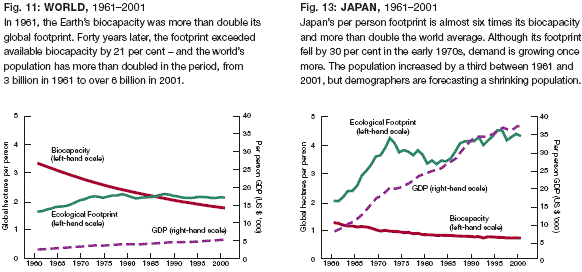 〔WWFの『News & Facts』の『Publications』の『Key Publications』の中の『Living Planet Report』の『Asia-Pacific "Living Planet Report" 2005』から〕 |
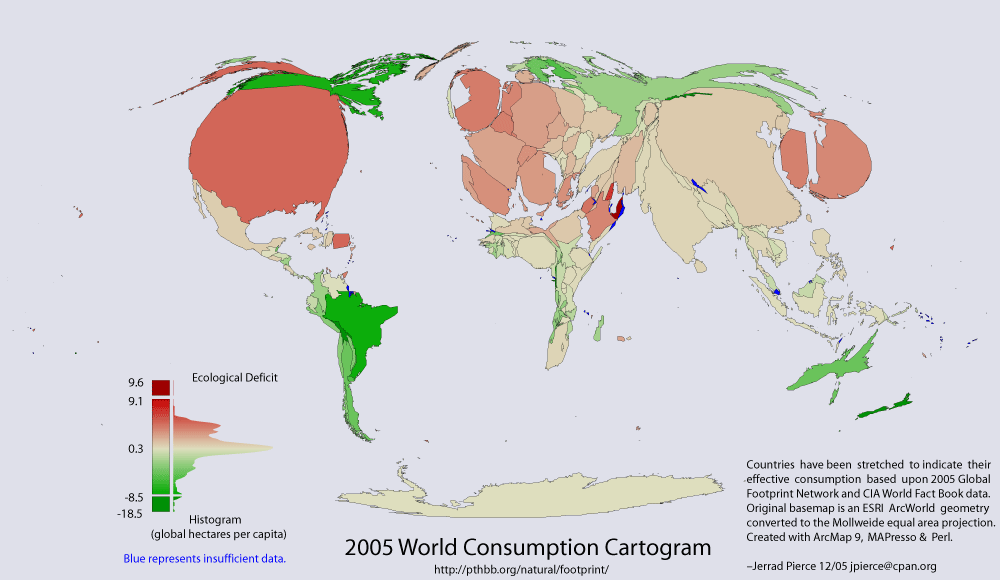 This thematic map shows two variables; 1) coloration
indicates reserve(green) − deficit(red)1 of national
biocapacity and 2) area indicates absolute consumption of biocapacity.
〔WWFの『News & Facts』の『Publications』の『Key Publications』の中の『Living Planet Report』からリンクされた『Fat Map (external link)』〕 |
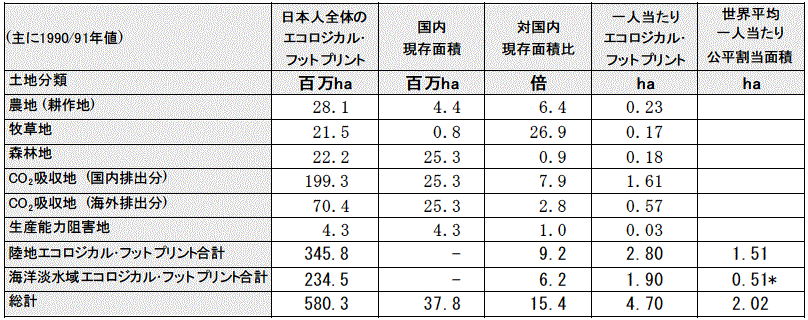 (*この数値計算は、和田およびS.Latham による) 出典:Wada 1999
 出典:Wackernagel, et al.
〔E-Square Inc.によるRSBSの中の『サステナビリティの科学的基礎に関する調査』の『第5部 「地球の環境収容力」をどうとらえるか』から〕 |
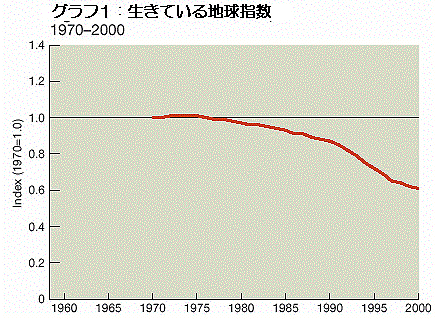 ■グラフ1:生きている地球指数(LPI)1970-2000 |
 ■グラフ2:生物圏に対する人間の需要は増加 |
| 〔WWFジャパンの『資料室』の『生きている地球レポート』の『生きている地球レポート 2004年度版』から〕 | |
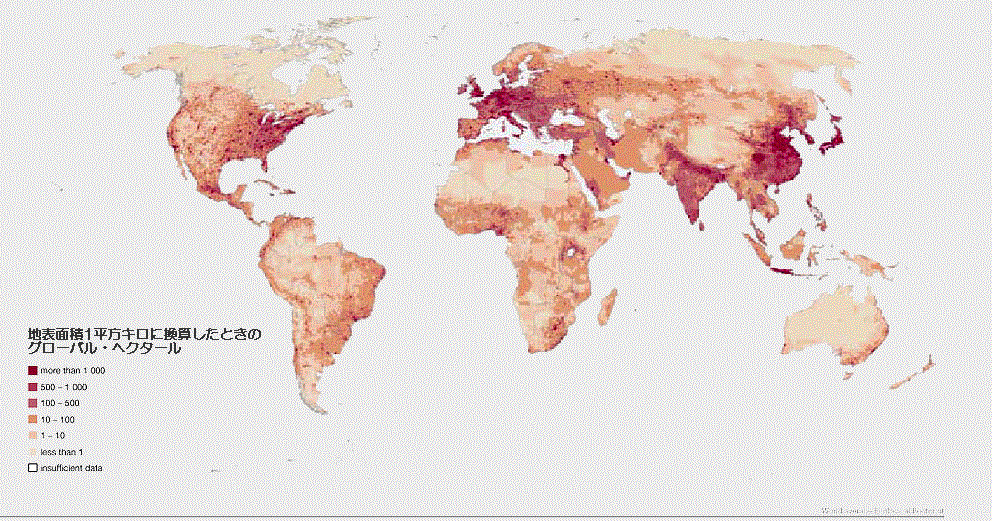 エコロジカル・フットプリント強度の分布 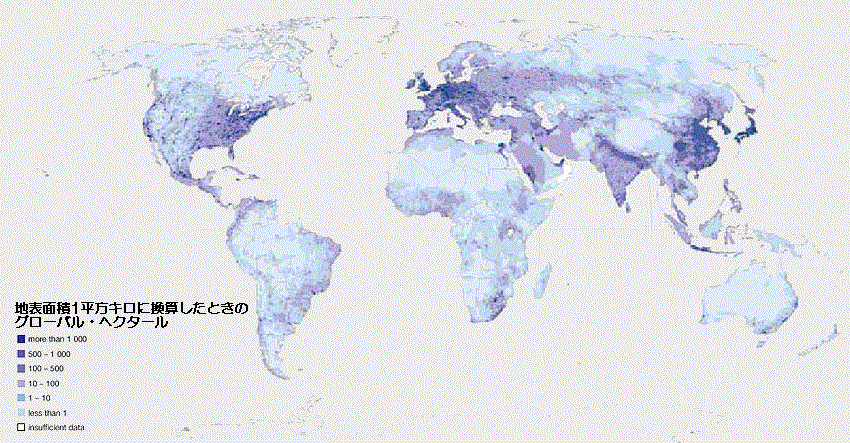 地図7:エネルギー・フットプリント強度の分布 〔WWFジャパンの『資料室』の『生きている地球レポート』の『生きている地球レポート 2004年度版』から〕 |
|
エコロジカル・フットプリント(ecological footprint:EF)とは、地球の環境容量をあらわしている指標で、人間活動が環境に与える負荷を、資源の再生産および廃棄物の浄化に必要な面積として示した数値である。通常は、生活を維持するのに必要な一人当たりの陸地および水域の面積として示される。 ウィキペディアによる『エコロジカル・フットプリント』から |
|
Ecological footprint (EF) analysis measures human demand on nature. It compares human consumption of natural resources with planet Earth's ecological capacity to regenerate them. It is an estimate of the amount of biologically productive land and sea area needed to regenerate (if possible) the resources a human population consumes and to absorb and render harmless the corresponding waste, given prevailing technology and current understanding. Using this assessment, it is possible to estimate how many planet Earths it would take to support humanity if everybody lived a given lifestyle. While the measure is widely used, some also criticize the approach. Wikipediaによる『Ecological footprint』から |
| マテリアルフットプリント |
|
|
|
|
| MediumによるNever Too Late To Mendの『持続可能な開発目標へ向けた進捗状況を測定する−目標12.持続可能な生産・消費形態を確保する−』(2018/4/24)から | |
|
・マテリアルフットプリント=国内最終需要を満たすために消費された天然資源量 |
| 環境省による平成29年版環境・循環型社会・生物多様性白書の第1部の第1章〔地球環境の限界と持続可能な開発目標(SDGs)〕の『第2節SDGsの各ゴールの関係と世界の現状』(2017?)から | |
MF=Material Footprint |
DMC=Domestic Material Consumption |
| Thomas O. Wiedmann et al.による『The material footprint of nations』(2015/5/19)から | |
| Daly's Triangle |
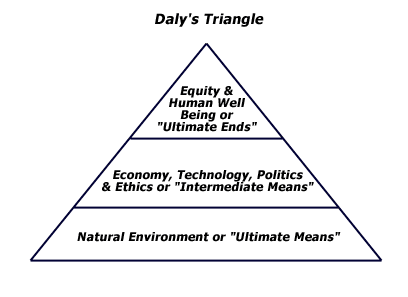 〔Sustainable Sonoma Countyの『Key Concepts』の中の『Sustainability Framework: Daly's Triangle』から〕 |